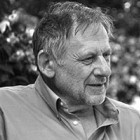
Автор
Кристофер Александер
Christopher Wolfgang Alexander
4.6
4.6
35оценок
Рейтинг автора складывается из оценок его книг. На графике показано соотношение положительных, нейтральных и негативных оценок.
| 5 | 25 | |
| 4 | 7 | |
| 3 | 3 | |
| 2 | 0 | |
| 1 | 0 | |
| без оценки |
14 |
35оценок
Лучшие книги Кристофера Александера
- 1 произведение
- 9 изданий на 3 языках
По популярности
-
 Кристофер Александер, Сара Исикава, Мюррей Сильверстейн
Язык шаблонов. Города. Здан...
Кристофер Александер, Сара Исикава, Мюррей Сильверстейн
Язык шаблонов. Города. Здан...
ISBN: 978-5-98062-079-0 Год издания: 2014 Издательство: Студия Артемия Лебедева Язык: Русский Аннотация
В книге описан «язык» для проектирования окружающей среды, единицы которого — шаблоны, — отвечают на архитектурные вопросы: какой высоты сделать окна, сколько этажей должно быть в здании, какую площадь в микрорайоне отвести под деревья и газоны. Издание содержит более 250 шаблонов — каждый включает описание той или иной проблемы, ее обсуждение, подкрепляемое иллюстрацией, и решение. С помощью этой книги возможно спроектировать дом для себя и своей семьи, разработать проект офиса, рабочей мастерской или общественного здания, совместно с соседями улучшить свой район и даже весь город. «Язык шаблонов» — одна из самых значимых книг XX века, которая до сих пор не издавалась на русском, хотя оказала сильнейшее влияние на развитие дизайна, проектирования, архитектуры и компьютерных наук, в том числе объектно-ориентированного программирования. -
 Кристофер Александер
The Timeless Way of Building
Кристофер Александер
The Timeless Way of Building
ISBN: 9780195024029 Год издания: 1979 Издательство: Oxford University Press -
 Кристофер Александер
The Phenomenon of Life: Nat...
Кристофер Александер
The Phenomenon of Life: Nat...
ISBN: 0972652914 Год издания: 2004 Язык: Русский Аннотация
What is happening when a place in the world has life? And what is happening when it does not? In Book 1 of this four-volume work, Alexander describes a scientific view of the world in which all space-matter has perceptible degrees of life, and -
 Кристофер Александер
A New Theory of Urban Design
Кристофер Александер
A New Theory of Urban Design
ISBN: 978-0195037531 Год издания: 1987 Издательство: Oxford University Press Язык: Английский Аннотация
The venerable cities of the past, such as Venice or Amsterdam, convey a feeling of wholeness, an organic unity that surfaces in every detail, large and small, in restaurants, shops, public gardens, even in balconies and ornaments. But this sense of wholeness is lacking in modern urban design, with architects absorbed in problems of individual structures, and city planners preoccupied with local ordinances, it is almost impossible to achieve.
In this groundbreaking volume, architect and planner Christopher Alexander presents a new theory of urban design which attempts to recapture the process by which cities develop organically. To discover the kinds of laws needed to create a growing whole in a city, Alexander proposes here a preliminary set of seven rules which embody the process at a practical level and which are consistent with the day-to-day demands of urban development.
He then puts these rules to the test, setting out with a number of his graduate students to simulate the urban redesign of a high-density part of San Francisco, initiating a project that encompassed some ninety different design problems, including warehouses, hotels, fishing piers, a music hall, and a public square. This extensive experiment is documented project by project, with detailed discussion of how each project satisfied the seven rules, accompanied by floorplans, elevations, street grids, axonometric diagrams and photographs of the scaled-down model which clearly illustrate the discussion.
A New Theory of Urban Design provides an entirely new theoretical framework for the discussion of urban problems, one that goes far to remedy the defects which cities have today. -
 Кристофер Александер
The Oregon Experiment
Кристофер Александер
The Oregon Experiment
ISBN: 9780195018240 Год издания: 1975 Издательство: Oxford University Press -
 Кристофер Александер
Notes on the Synthesis of Form
Кристофер Александер
Notes on the Synthesis of Form
Год издания: 1974 Издательство: Harvard University Press Аннотация
"These notes are about the process of design: the process of inventing things which display new physical order, organization, form, in response to function." This book, opening with these words, presents an entirely new theory of the process of design.
In the first part of the book, Mr. Alexander discusses the process by which a form is adapted to the context of human needs and demands that has called it into being. He shows that such an adaptive process will be successful only if it proceeds piecemeal instead of all at once. It is for this reason that forms from traditional unselfconscious cultures, molded not by designers but by the slow pattern of changes within tradition, are so beautifully organized and adapted. When the designer, in our own self-conscious culture, is called on to create a form that is adapted to its context he is unsuccessful, because the preconceived categories out of which he builds his picture of the problem do not correspond to the inherent components of the problem, and therefore lead only to the arbitrariness, willfulness, and lack of understanding which plague the design of modern buildings and modern cities.
In the second part, Mr. Alexander presents a method by which the designer may bring his full creative imagination into play, and yet avoid the traps of irrelevant preconception. He shows that, whenever a problem is stated, it is possible to ignore existing concepts and to create new concepts, out of the structure of the problem itself, which do correspond correctly to what he calls the subsystems of the adaptive process. By treating each of these subsystems as a separate subproblem, the designer can translate the new concepts into form. The form, because of the process, will be well-adapted to its context, non-arbitrary, and correct.
The mathematics underlying this method, based mainly on set theory, is fully developed in a long appendix. Another appendix demonstrates the application of the method to the design of an Indian village.